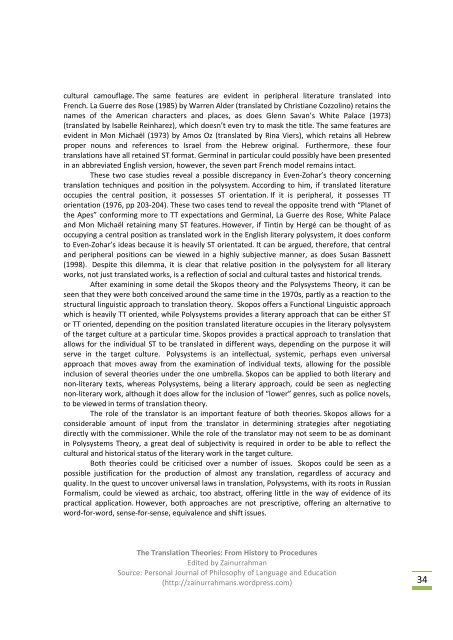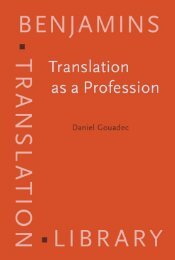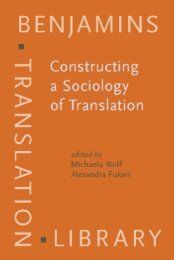Translation Theories.pdf
Translation Theories.pdf
Translation Theories.pdf
Create successful ePaper yourself
Turn your PDF publications into a flip-book with our unique Google optimized e-Paper software.
cultural camouflage. The same features are evident in peripheral literature translated into<br />
French. La Guerre des Rose (1985) by Warren Alder (translated by Christiane Cozzolino) retains the<br />
names of the American characters and places, as does Glenn Savan’s White Palace (1973)<br />
(translated by Isabelle Reinharez), which doesn’t even try to mask the title. The same features are<br />
evident in Mon Michaël (1973) by Amos Oz (translated by Rina Viers), which retains all Hebrew<br />
proper nouns and references to Israel from the Hebrew original. Furthermore, these four<br />
translations have all retained ST format. Germinal in particular could possibly have been presented<br />
in an abbreviated English version, however, the seven part French model remains intact.<br />
These two case studies reveal a possible discrepancy in Even-Zohar’s theory concerning<br />
translation techniques and position in the polysystem. According to him, if translated literature<br />
occupies the central position, it possesses ST orientation. If it is peripheral, it possesses TT<br />
orientation (1976, pp 203-204). These two cases tend to reveal the opposite trend with “Planet of<br />
the Apes” conforming more to TT expectations and Germinal, La Guerre des Rose, White Palace<br />
and Mon Michaël retaining many ST features. However, if Tintin by Hergé can be thought of as<br />
occupying a central position as translated work in the English literary polysystem, it does conform<br />
to Even-Zohar’s ideas because it is heavily ST orientated. It can be argued, therefore, that central<br />
and peripheral positions can be viewed in a highly subjective manner, as does Susan Bassnett<br />
(1998). Despite this dilemma, it is clear that relative position in the polysystem for all literary<br />
works, not just translated works, is a reflection of social and cultural tastes and historical trends.<br />
After examining in some detail the Skopos theory and the Polysystems Theory, it can be<br />
seen that they were both conceived around the same time in the 1970s, partly as a reaction to the<br />
structural linguistic approach to translation theory. Skopos offers a Functional Linguistic approach<br />
which is heavily TT oriented, while Polysystems provides a literary approach that can be either ST<br />
or TT oriented, depending on the position translated literature occupies in the literary polysystem<br />
of the target culture at a particular time. Skopos provides a practical approach to translation that<br />
allows for the individual ST to be translated in different ways, depending on the purpose it will<br />
serve in the target culture. Polysystems is an intellectual, systemic, perhaps even universal<br />
approach that moves away from the examination of individual texts, allowing for the possible<br />
inclusion of several theories under the one umbrella. Skopos can be applied to both literary and<br />
non-literary texts, whereas Polysystems, being a literary approach, could be seen as neglecting<br />
non-literary work, although it does allow for the inclusion of “lower” genres, such as police novels,<br />
to be viewed in terms of translation theory.<br />
The role of the translator is an important feature of both theories. Skopos allows for a<br />
considerable amount of input from the translator in determining strategies after negotiating<br />
directly with the commissioner. While the role of the translator may not seem to be as dominant<br />
in Polysystems Theory, a great deal of subjectivity is required in order to be able to reflect the<br />
cultural and historical status of the literary work in the target culture.<br />
Both theories could be criticised over a number of issues. Skopos could be seen as a<br />
possible justification for the production of almost any translation, regardless of accuracy and<br />
quality. In the quest to uncover universal laws in translation, Polysystems, with its roots in Russian<br />
Formalism, could be viewed as archaic, too abstract, offering little in the way of evidence of its<br />
practical application. However, both approaches are not prescriptive, offering an alternative to<br />
word-for-word, sense-for-sense, equivalence and shift issues.<br />
The <strong>Translation</strong> <strong>Theories</strong>: From History to Procedures<br />
Edited by Zainurrahman<br />
Source: Personal Journal of Philosophy of Language and Education<br />
(http://zainurrahmans.wordpress.com) 34

















